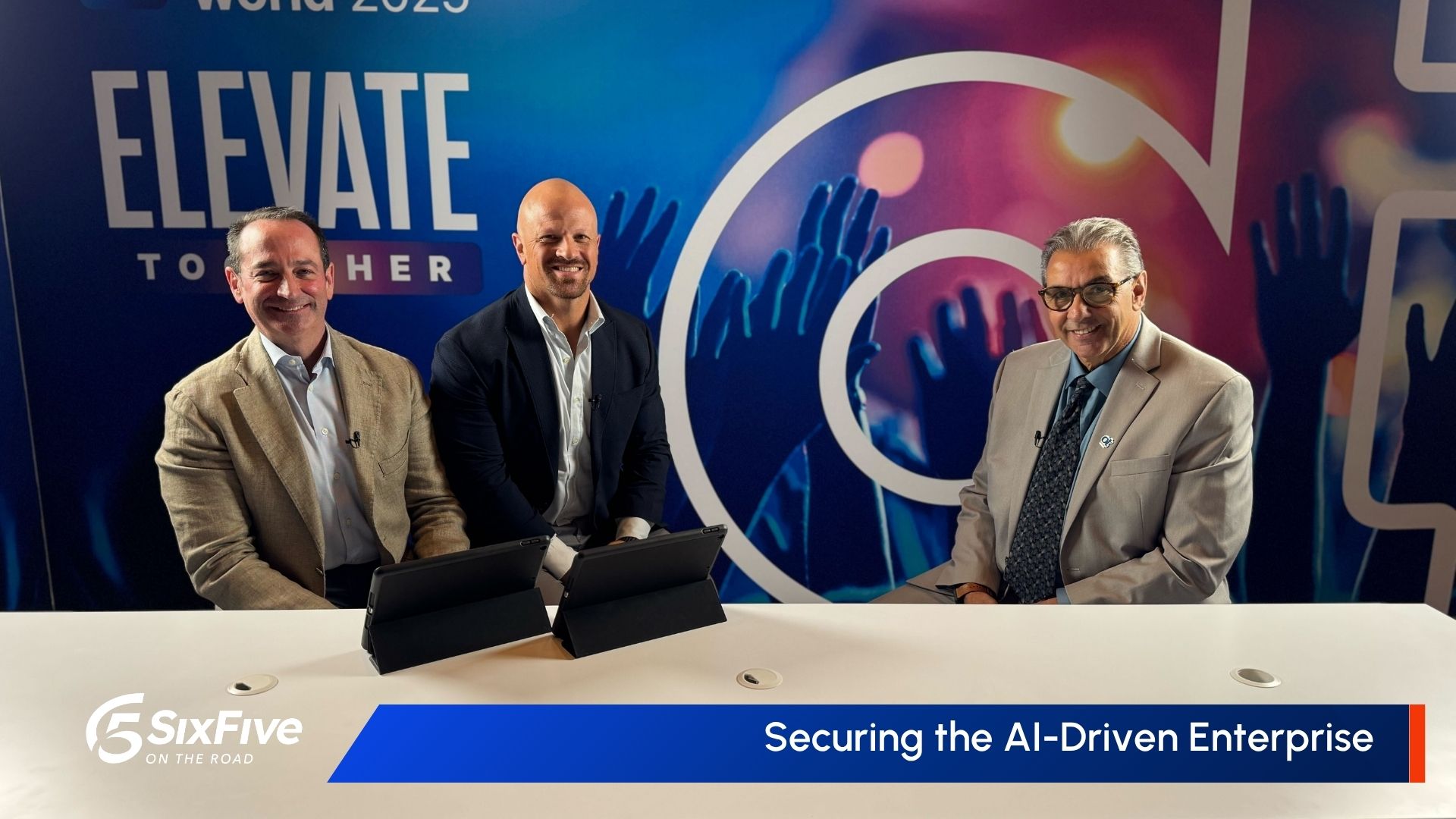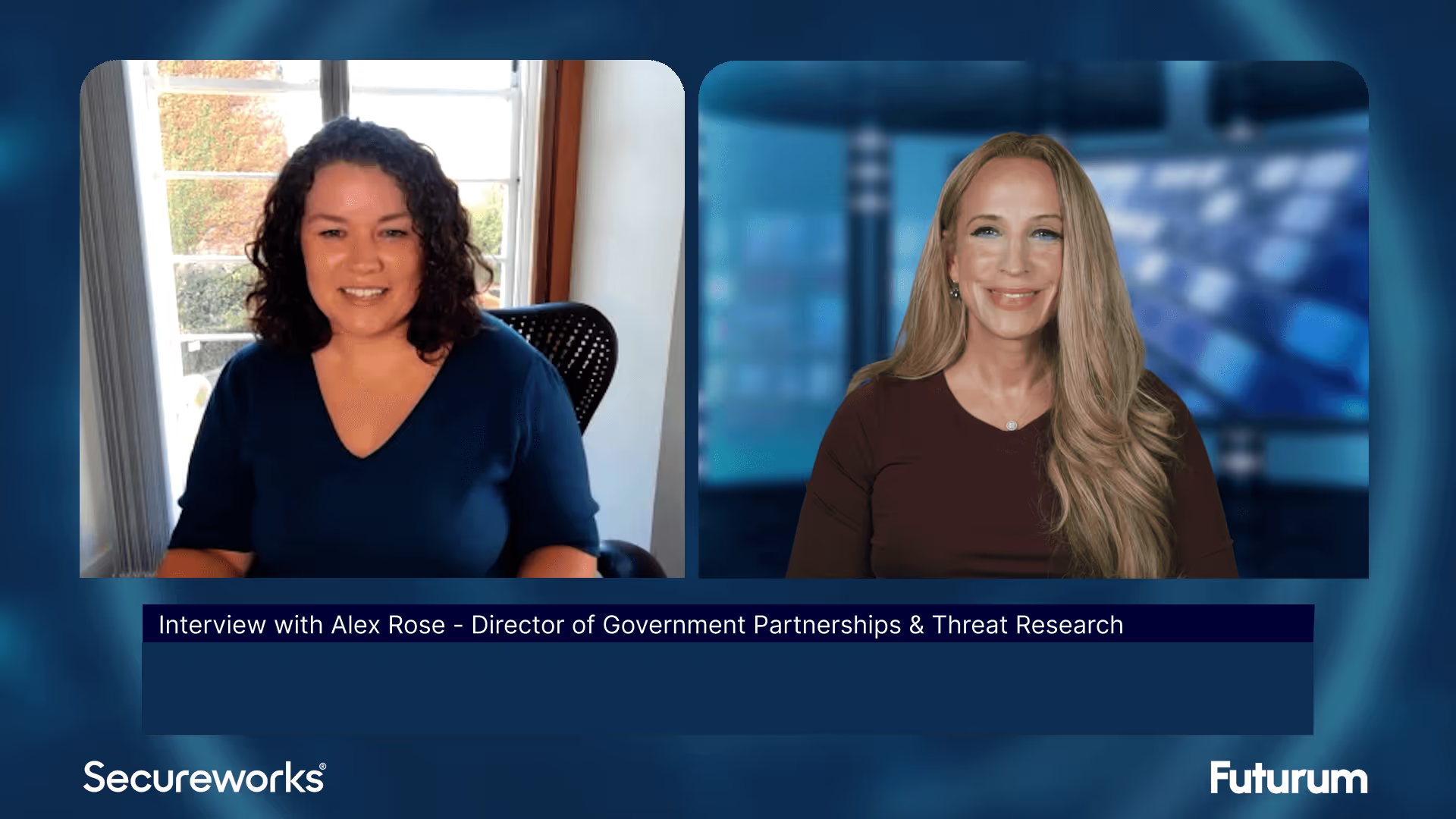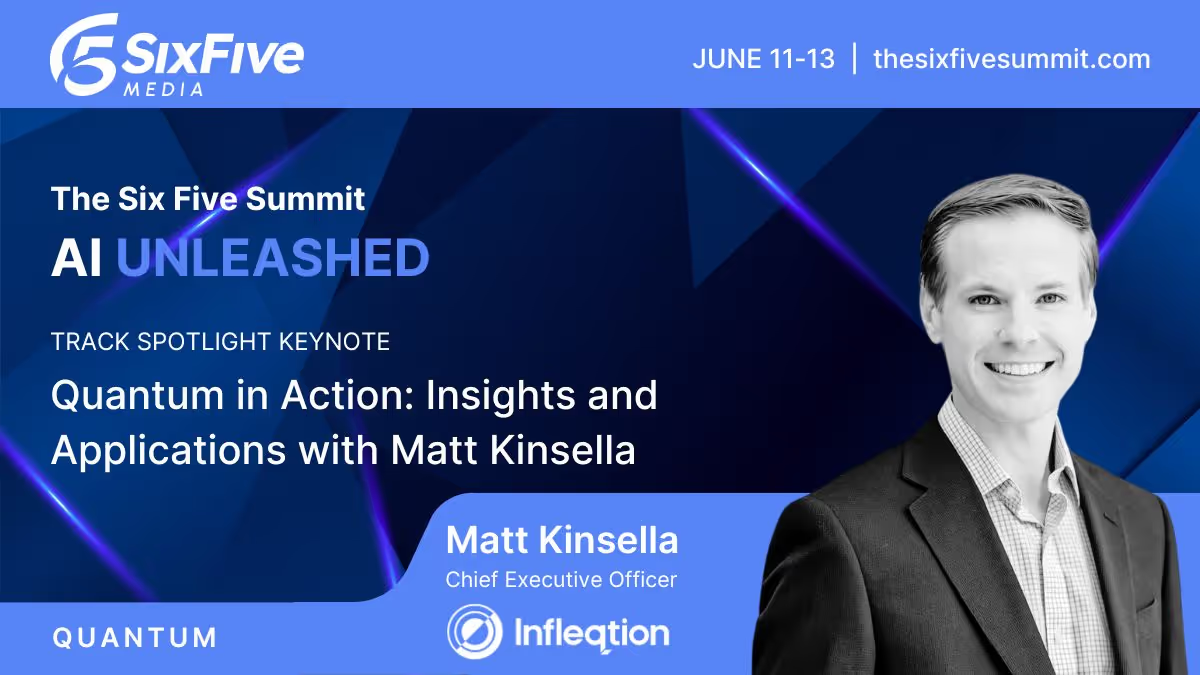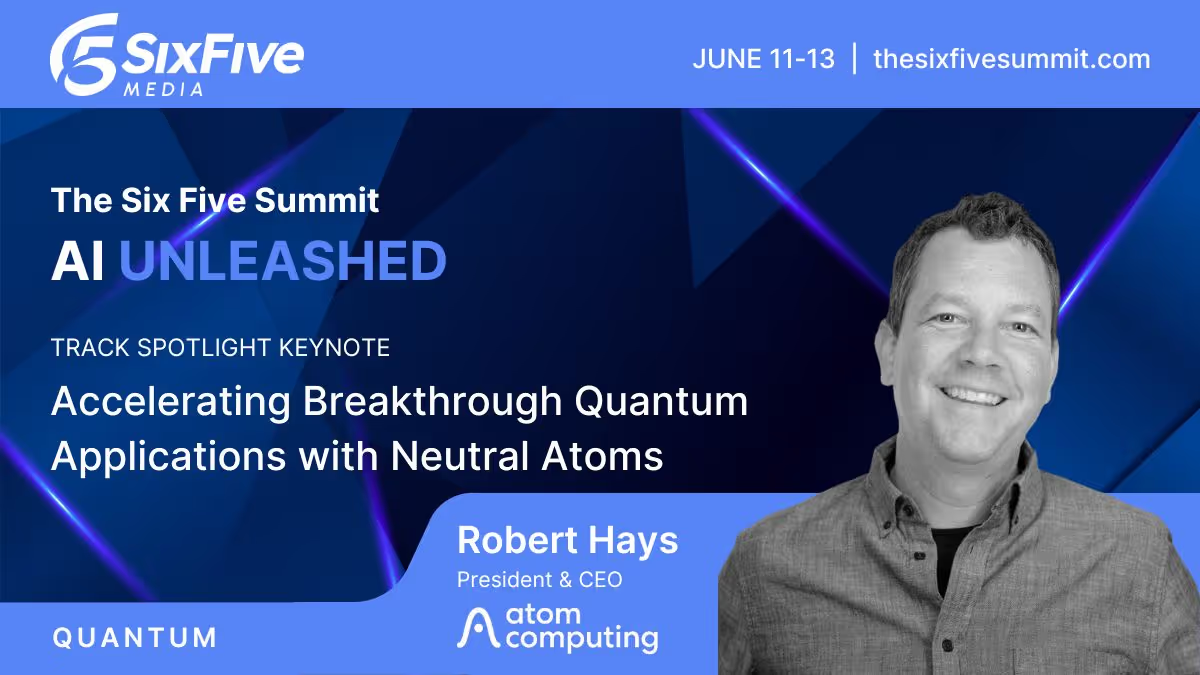Home
Inside the Cisco-NVIDIA Partnership: The Future of AI-Powered Collaboration - Six Five On The Road
Inside the Cisco-NVIDIA Partnership: The Future of AI-Powered Collaboration - Six Five On The Road
Snorre Kjesbu, SVP & GM at Cisco, and Deepu Talla, VP at NVIDIA, join Melody Brue to discuss how a decade of partnership is empowering AI-driven collaboration and what’s ahead for the employee experience in the modern workplace.
How are Cisco and NVIDIA teaming up to shape the future of employee experience?
Host Melody Brue is joined by Cisco’s SVP & GM of Cisco Collaboration, Snorre Kjesbu, and NVIDIA’s VP of Robotics & Edge AI, Deepu Talla, for a conversation on the future of AI-powered collaboration. This discussion highlights how their strategic partnership is embedding intelligence directly into the tools people use every day, with a focus on Cisco’s three-layer AI framework and the concept of “Distance Zero,” all while prioritizing secure, human-centered innovation in workplace transformation.
Key Takeaways Include:
🔹A Decade-Long Strategic Alliance: Cisco and NVIDIA’s durable partnership has been instrumental in shaping enterprise AI collaboration, driven by shared vision and long-term innovation.
🔹Composed Plate AI Framework: Cisco’s differentiated hybrid approach that integrates artificial intelligence across the network — at the edge, in the cloud, and in control — to deliver precise, secure, and scalable intelligence for business customers.
🔹Embedded AI for Seamless Collaboration: Integrating AI directly into platforms transforms the employee experience, reducing barriers and enhancing real-time productivity.
🔹“Distance Zero” Vision: AI enables immersive, frictionless collaboration experiences that make remote interactions feel as natural as in-person meetings.
🔹Looking Ahead: The next three to five years promise bold shifts in AI’s role at work, with further surprises expected as technology continues to change collaboration paradigms.
Learn more at Cisco.
Watch the full video at sixfivemedia.com, and be sure to subscribe to our YouTube channel so you never miss an episode.
Or listen to the audio here:
Disclaimer: Six Five On The Road is for information and entertainment purposes only. Over the course of this webcast, we may talk about companies that are publicly traded, and we may even reference that fact and their equity share price, but please do not take anything that we say as a recommendation about what you should do with your investment dollars. We are not investment advisors, and we ask that you do not treat us as such.
Melody Brue: Hello, welcome to Six Five on the Road. I'm Melody Brue, I'm here at WebExOne in San Diego. I have here with me Snorre Kjesbu, SVP and GM of Cisco Collaboration, and Deepu Talla, VP of Robotics and Edge AI at Nvidia. Welcome.
Snorre Kjesbu: Thank you for having us.
Melody Brue: Yeah, thank you guys for being here. So I made a little bit of a joke yesterday about having somebody from Nvidia on the stage at a big conference. And I said, so if you don't have somebody from Nvidia on the stage, do you even AI? But you guys have a really long history, a very deep relationship. Tell me a little bit about that when it started and how that kind of gives you a little bit of a, no pun intended, edge in this space.
Snorre Kjesbu: And so at Cisco we've been developing equipment for people to people communication for a long time. And you know, 10 years ago we were really at a shift in our technology. We were actually looking for new technology. And in that time we actually saw a company called Nvidia. And you know, today it's so obvious that they're the coolest kids on the block. A decade ago they were still the coolest kid on the blocks, but no one knew, not as, not as known as. And then we sat down and we started looking at the common possibility of really developing things on the edge and out in the video, conferencing equipment together with using machine learning, as we discussed at the time, and AI and how that could improve that. And then I was lucky enough to meet Deepu, he's one of the smartest people I know. And we started discussing and we started the partnership a year later. The first products came out from Cisco.
Deepu Talla: Yeah, I mean, very well said Snorri. And from our perspective, Nvidia is a platform computing company. We work with the leaders in the industry, whichever vertical space. We always pride in working in a deep technology partnership. So even though it's been 10 years, this is exactly how we expected a multi decade deep technology partnership where we take our technology and help Cisco integrate our technology into their product and platform.
Melody Brue: What was that first product that you developed together?
Snorre Kjesbu: The first product we developed together was actually a video conferencing unit. It was a bar that we have and we have that product line still, but obviously with brand new technology because we've been together working through a number of generations of technology from.
Melody Brue: Yeah, it's a great long history. You talk about AI at the edge, in the cloud and in control. You call it a precisely composed plate, rather than an AI stew. So can you break that down for us in terms of what that means and why it matters for your customers?
Snorre Kjesbu: Let me just tee it up briefly and then pass it to deeper. You know, I meet a lot of people, a lot of customers, a lot of organizations, and a number of them look at AI as just one massive thing. Or what I say is that they throw everything into one saucepan and try to make a stew. I think the way to think about AI is that first of all, it's the most significant shift that we've seen in our lifetime. The second piece is that there are different ways to do it. We think about it as AI at the edge, which is what you can actually do out all the way at the edge. In our case, in the video conferencing units, AI in the clouds around large language models where you have a ton of processing and really advanced things that can be done. And then with Cisco, we talk a lot about AI for control, which is actually helping the ones that own and operate the equipment as well, so that they can scale and get superpowers.
Melody Brue: Good way to put it, superpowers.
Deepu Talla: So when people are talking about the edge, it turns out there's a device edge and you can break down the edge into multiple levels. But the easiest way to think about it is in the device or in the machine and something on premise. And then there's the data center and AI, depending on the use case, is going to be hybrid, edge, cloud, wherever the AI makes sense to run for that particular algorithm or particular use case. Most of the time what we end up seeing is that it's going to be hybrid.
Melody Brue: Instead of layering AI on top, you're embedding it into the devices. So how does that change the experience for the end user?
Snorre Kjesbu: We're actually doing both, but by also having new capabilities in the devices. There are a number of things there that you can do really fast, you can really do it on really high resolution images that you don't have to transfer back, which makes it snappy, it makes it quick, it can do the things that you want. Like now we've just launched what we call the director or the AI director, which is really having a director in the device that produces the most optimum view from any type of room. And having the Nvidia capabilities all the way out in the device is providing a massive competitive advantage for us because we can do so many things with it.
Deepu Talla: Yeah. When we first started this journey 10 years ago, a lot of the embedded and AI development was monolithic software. Whereas if you look at the latest technology in cloud, it's disaggregated, distributed and compute can scale up or scale out. That software was not available on the device. But in the last five years the whole industry has migrated to be hybrid, edge, cloud. It's called cloud native. You can run whichever piece of software wherever it makes sense. So because of that now we are seeing the fungibility. Today you might decide that, you know, there's a new software capability, the edge processor might not be powerful enough, so you start in the cloud, but then tomorrow it might be optimized and you might be able to move it to the edge. So that gives you the flexibility to move it hybrid edge and cloud, that flexibility.
Melody Brue: So that's really part of the employee experience, the end user experience when they're in that room and they have what you call distance zero where everybody feels like they could be in, in front of each other. And actually this was so great for me. I got to experience this last week at the Austin opening of the Cisco office. So many of the things that, you know, I've seen in discussions, in, in renderings really came to life in that office building and it's really come to life here. So when you look at eliminating that friction, allowing for everybody to be sort of seen, heard, what does that mean to you? Distance 0 and how much is the technology embedded into that, really enabling that experience to come to life for people.
Snorre Kjesbu: So distance zero is a vision and on the way to distance zero we're taking a number of steps. I think I'm going to chase distance zero for the rest of my life. And I like that. That's actually putting a really bold goal, having just two words to try to strive for. And it's all about see and be seen. It's all about heard and be, to hear and, and, and be heard. But I think that it's more than that. So that's all about the experience when we are in the room. But what we do is to combine that with what Deepa just said as well, is to combine that with all the capabilities that you can have with AI in the cloud as well. So one of the things that we have launched now for instance, is that even in a local meeting you can actually have the note taker which will allow you in any type of meeting, you just press a button even if there's no one to use the cloud for taking the notes also, also there. So I think what you will see and this is just scratching the service surface honestly. And I think we should talk about some of the dreams we have going forward, about what more we can do. But I think it's combining them. That's where the power really, really is.
Melody Brue: How can Nvidia work into that vision? Where is that? And I think that vision is becoming a reality. I mean it's really, it's. It was very clearly illustrated in the office and Austin and other him, other offices that you have. But I loved seeing it there, I loved seeing it at the demo floor yesterday, allowing people to really experience that. So how does Nvidia fit into that vision?
Deepu Talla: That's perfect for us because we are providing the computer runtime. It's the fastest you can buy in the industry at the lowest power possible and it's fully software programmable and it provides all the latest, greatest AI and we continue to update the software. That's the other key part. So when Cisco launches the Aerobex device as an example, that's just the beginning. It's not the end of the product. For the next several years they're updating software, adding new features and capabilities. And that comes because we are. It's a programmable processor and we're able to offer our technology and Cisco is able to leverage that technology. For example, you can imagine that in the near future there's gotta be more and more LLMs or VLMs that they're going to be running on the Webex devices. The hardware is not going to change. It's hardware that they already released. Right. We can update software. So Nvidia and Cisco, that's a perfect partnership because of the technology capability that we bring in and we embed our technology into Cisco's products.
Snorre Kjesbu: And if I can tag on to that. So one thing that Nvidia and Deeper and his team has done a lot is to challenge us because they come at this from a different angle than us. And he will ask questions but why don't you do this? Or have you thought of that? And, and I'll take one example that we're launching here, which is actually what we call the digital twin. And I think you spoke about it very early. Great earlier here today, which is, you know, when you're training robots on just robots, you're doing that at the clock speed, the regular clock spill, you know, getting any advantages and you haven't then built models and simulation that's really driving it there. When you said that to us, we started thinking what if we take and build a digital twin of the room and we take that digital twin of the room. Then we can test out where you place the microphones, what the surfaces like, what the acoustics like, how can you tune that? And I think that the greatness of this partnership has been the way that Nvidia has been challenging us to really think differently about what we can deliver. And that tool is for the first time helping the IT organization with the physical room. And they have been able to do that before. So I think that came out of a discussion you and I had.
Deepu Talla: Fantastic. That's music to my ears. We have more products to sell you.
Melody Brue: Yeah, that was impressive. The Digital twin. I mean when you think about how many times people have to redo things, reconfigure, and that gives people the ability to really actually see it, test it in that. I mean it's, it's kind of mind blowing when you think about it, that you really can simulate that experience. You talked a little bit today, or we heard a little bit today in the keynote about some of the features that are being surfaced like being able to control noise and exactly what parts of the room you want to tune out. So how does that like when you test with a digital twin, how does that enable companies to really plan?
Snorre Kjesbu: Well now what Digital twin is doing is that it allows us to simulate the physical room and with our AI ceiling microphone Pro, we can then actually run that. We can look at coverage, but we could also have audio exclusion songs, for instance, where the door is or whether there might be more noise. You could actually then test that in the digital twin and when you see that that coverage is right, then you can actually roll it out in the real world so you get what they are doing on steroids. When it comes to simulation and our way of doing it, we can actually allow the IT organization to try out things on the digital twin and then apply it in hardware afterwards.
Deepu Talla: Yeah, in fact, if you look at this capability of the so called digital twin is actually one of the first use cases. You're seeing it across factories. Before you even lay out a factory, where would you place all your workstations? What's their ideal spacing for machines to move humans to work? The work cells, all of that are simulating the light. And you know, all of that is now moving on to digital twins because the change orders are going to be significantly reduced and the time to market or the time to build is significantly faster. We're seeing that across multiple industries. In fact, we have one of our partners, Foxconn, who builds our latest infrastructure products based on Grace Black Hole 200. There's a 400 meter long factory that was built in Guadalajara and they're building one more in Houston right now as we speak. That was all modeled in a digital twin before, you know, you had real construction begin.
Melody Brue: Yeah.
Deepu Talla: Where do the robots go? Where do humans go? Where does it, how do you model the different traffic patterns? So Virtual factory initiative is what we call it. So that same idea absolutely makes sense for WebEx to make it easy to set up a conference room. Instead of doing so many trial and errors of moving things, you can do all of that in a digital twin and you get a fairly good answer and then you know exactly where to place all the different sensors. Setup will become far easier.
Melody Brue: It's really amazing how smart the technology is when you can. It knows the difference between a person in the room or a person outside of a window. It's really actually quite impressive. So this partnership, it's been a long time in the making. You have huge visions over the next three to five years. You said this could be, you know, it's two words that guide you for, could be for the rest of your life, for the rest of your career. But what does this partnership look like? What are your big, kind of big dreams and what are you thinking about having? It's great that you challenge one another, but where do you see something next coming up?
Deepu Talla: Well, one of the things I observed working in robotics for the last 10 years, every year there was pretty good improvement compared to the previous year until a couple of years ago, suddenly with ChatGPT and that type of technology, AI improvements are happening in step function. What I'm super excited by and can't wait to see is how the collaboration team at Cisco is going to take advantage of some of these new capabilities and suddenly there's going to be a step function capability with respect to the meeting rooms. I can't wait to see that.
Snorre Kjesbu: And if I can add on to that. You know, up to now we have mostly been focusing on people to people communication. But what you will see as well is it will be people to AI and AI to AI. And I think that one of the things that I'm super excited about is not only will there be people in the meeting, but there will be AI, you know, resources in that meeting. Really like a co worker, an AI co worker that's next to me to be able to include these as well and then AI to AI as well is how between our AI agent and do you actually communicate and pass data? So what used to be only people to people will be people to people, people to AI and AI to AI. That's interesting.
Deepu Talla: Yeah. I mean you can think of when we are in a meeting and we are talking about something like a massive spreadsheet. You can now ask an AI crunch that spreadsheet and show me what's the answer instead of taking an action coming back later in the meeting. So you can now see that multiple AI agents are working with you and then the human to human communication becomes extremely more productive.
Melody Brue: Well, this has been an amazing conversation. I look forward to seeing all of the new innovations that come out over the next couple of years as I'll be of course following along. Thank you so much for joining me for this chat and thank you all for tuning in to this six five on the road here at WebExOne in San Diego. Please like and subscribe. Follow us along for more news SixFiveMedia.com and we will see you next time.
MORE VIDEOS

Why Rack-Scale Architecture Matters: Preparing Data Centers for the Next Wave of AI – Six Five On The Road
David Schmidt, Sr. Director Product Management at Dell Technologies, joins hosts to discuss why rack-scale architecture is critical for data centers adapting to AI demands, with insights on operational priorities, cooling, and deployment lessons.

Building an AI-Ready Enterprise - Six Five On The Road
Shannon Bell, EVP, Chief Data Officer & CIO at OpenText, joins Six Five to discuss strategies for building an AI-ready enterprise, including bridging the AI ROI gap, embracing unified data platforms, and cross-functional management of digital agents.

Securing the AI-Driven Enterprise - Six Five On the Road
Muhi Majzoub, EVP of Security Products at OpenText, joins Six Five On the Road hosts to discuss how AI is making an immediate operational impact on enterprise security, redefining "secure AI," and shaping the future of cybersecurity platforms.
Other Categories
CYBERSECURITY

Threat Intelligence: Insights on Cybersecurity from Secureworks
Alex Rose from Secureworks joins Shira Rubinoff on the Cybersphere to share his insights on the critical role of threat intelligence in modern cybersecurity efforts, underscoring the importance of proactive, intelligence-driven defense mechanisms.
QUANTUM

Quantum in Action: Insights and Applications with Matt Kinsella
Quantum is no longer a technology of the future; the quantum opportunity is here now. During this keynote conversation, Infleqtion CEO, Matt Kinsella will explore the latest quantum developments and how organizations can best leverage quantum to their advantage.

Accelerating Breakthrough Quantum Applications with Neutral Atoms
Our planet needs major breakthroughs for a more sustainable future and quantum computing promises to provide a path to new solutions in a variety of industry segments. This talk will explore what it takes for quantum computers to be able to solve these significant computational challenges, and will show that the timeline to addressing valuable applications may be sooner than previously thought.




